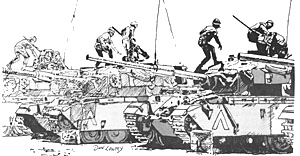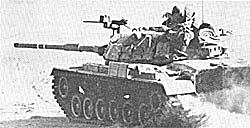 During the Arab-Israeli war of 1973, many of the presuppositions regarding the strengths and weaknesses of the various tanks were shown to be totally false, and the results were contrary to what most "authorities" had predicted.
During the Arab-Israeli war of 1973, many of the presuppositions regarding the strengths and weaknesses of the various tanks were shown to be totally false, and the results were contrary to what most "authorities" had predicted.
Prior to the war, the Soviet T62 trials was hailed as the ultimate in modern design techniques and application due to its low profile, highly sophisticated ballistic armor, huge 115mm smoothbore cannon and snappy performance due to a light weight and good engine. Unfortunately, the vehicle's performance characteristics when combined in actual practice yielded a tank with a myriad of handicaps and drawbacks.
To "briefly" summarize the foibles of the T62, one would have to cover almost every aspect of the tank, so bad was the integrated performance of all the components. Taken in short, the range finder was range limited, the smoothbore gun was inaccurate, the engine overheated, the armor was lousy (despite having the same thickness and slope as Western tanks , the quality was poor which is something most wargame designers overlook) and the small internal area of the vehicle fatigued the crew and forced the Russians to place ammo, fuel tanks and other vital elements in highly vulnerable places (they actually put the main fuel tanks adjacent to the front hull armor, where even ricochets that failed to penetrate often generated enough heat to ignite the fuel).
 As if the technical aspects of the tank weren't bad enough, Soviet doctrine requires the gunners to track the target with the range finder and ballistic computer prior to getting off a shot, which, together with the problems associated with putting those enormous 115mm shells in the gun (in a closed space), gave the Israeli's with their visual aiming techniques (due to the flat trajectory of APDS ammo) the first shot and a higher subsequent rate-of-fire. While T62s looked good from a design viewpoint, in actual combat they were outshot, outmaneuvered (T62 took, had a nasty habit of snapping at high speeds) and totally outclassed by the Western-style tanks.
As if the technical aspects of the tank weren't bad enough, Soviet doctrine requires the gunners to track the target with the range finder and ballistic computer prior to getting off a shot, which, together with the problems associated with putting those enormous 115mm shells in the gun (in a closed space), gave the Israeli's with their visual aiming techniques (due to the flat trajectory of APDS ammo) the first shot and a higher subsequent rate-of-fire. While T62s looked good from a design viewpoint, in actual combat they were outshot, outmaneuvered (T62 took, had a nasty habit of snapping at high speeds) and totally outclassed by the Western-style tanks.
After being hyped up by all of the written accounts of the 1973 war, where handfuls of Israeli Patturion tanks (modified Centurions) would take on upwards of 20 to 30 Arab T62s or T55s, the playing of most miniature rules, the Tractics in particular, was somewhat of a letdown. While the accuracy of the T62's gun was normally rated somewhat below the 105mm used by the Israelis, in the final account the Soviet tanks came out almost the equal of the M60s, M48s and Patturions that they met in battle. This was very disappointing, since despite Tractics' obvious dedication to trivia and the inclusion of everything that even appeared to have an impact on armored combat, the important distinctions and differences between the Arab and Israeli AFVs was totally lacking (as a matter of fact, in Tractics the T62 is superior to the M60 at long ranges due to the better HEAT ammo and the smaller target size, which is directly opposite to what transpired in the desert battles - the M60 totally outshot the opposition).
In fairness to the authors of Tractics, who did a marvelous job and set up an excellent system for simulating tank combat and all the factors that affect it, it should be noted that the basic work was completed prior to the 1973 War, and the 'real combat' defects of the Russian equipment had yet to disprove the enthusiastic claims and opinions of the people who felt that Russian tank design was vastly superior to the pitiful American attempts and the outdated English vehicles (Centurions were introduced at the very end of WWII). It was clear, however, from playing with the rules and trying to reproduce the ability of the Israelis to defeat hordes of enemy tanks with relatively small numbers, that the rules were badly out of date, and required a fairly extensive revision to cover the subtle points of modern armored warfare.
Having the advantage of "actual" battle accounts and analyses that were not available during the preparation of Tractics, an attempt has been made to update the game system so that the trivia fan and the modern armor enthusiast can use Tractics to simulate modern warfare with a fair degree for accuracy and detail. While many hours of "research" have gone into the following list of revisions, since I wasn't a participant in the fighting (thank God for that) and do not have access to the technical data needed to really be 100 per cent "accurate" (what rules are?) the revisions represent a good starting point for someone who really thrives on super detail in their gaming.
As a minimum, the incorporation of the recommended changes will spice up the games and set up a "David and Goliath' sort of situation where quantity (the Soviet tanks) will be pitted against quality (Western equipment), which I've found to be a surefire way to set up interesting and realistic games, Should the reader wish to further modify the recommendations, they're welcome to tinker, and, if possible, I'd appreciate receiving a copy of any further refinement attempts to the modern armor section of Tractics.
Revisions
Main Battle Tanks, 1973
Glossary of Terms
Back to Campaign #92 Table of Contents
Back to Campaign List of Issues
Back to MagWeb Master Magazine List
© Copyright 1979 by Donald S. Lowry
This article appears in MagWeb (Magazine Web) on the Internet World Wide Web. Other military history articles and gaming articles are available at http://www.magweb.com